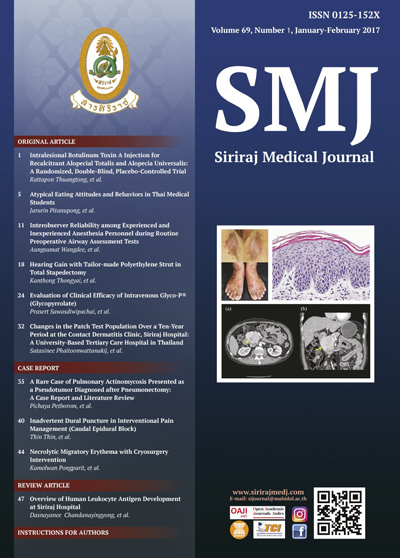Evaluation of Clinical Efficacy of Intravenous Glyco-P® (Glycopyrrolate)
Keywords:
Glycopyrrolate, Glyco-P®, antisialagogue, secretion reduction, anticholinergic, atropineAbstract
Background: Glycopyrrolate has been widely used globally as an adjunct in anesthesia since early 1970’s. However, this agent has never been used in Thailand until recent introduction of the Glyco-P® (0.2 mg IV glycopyrrolate). The clinical efficacy and safety of intravenous glycopyrrolate in Thai population was unknown.
Objective: To evaluate the clinical efficacy of intravenous glycopyrrolate in 3 areas 1) antisialagogue 2) effect on heart rate and 3) anticholinergic effects when used with neostigmine for neuromuscular blockade reversal.
Methods: Single-centered, prospective observational study, which enrolled 121 ASA 1-3 patients receiving intravenous sedation or general anesthesia. The patients were given an IV glycopyrrolate and had their data collected and categorized by clinical indications into 3 groups-secretion group (SCR), heart rate group (HR) and reversal of neuromuscular blockade group (NMR). We recorded heart rate and blood pressure at baseline and every 5 minutes and recorded secretion score every 10 minutes after treatment.
Results: Intravenous glycopyrrolate demonstrated good antisialagogue properties as 76.1-85.6% of patients in SCR group recorded minimal secretion score, between 0-1 out of 5, at 10-20 minutes. A mild to modest chronotropism was observed as mean heart rate was increased from 72.85 to 79.85 within 5 minutes. When used with neostigmine for reversal of neuromuscular blockade, the well-balanced anticholinergic effect was seen as stable heart rate and minimal secretion.
Conclusion: An intravenous Glyco-P® demonstrates its clinical efficacy in Thais at the same recommended dose as previously described in western population for both antisialagogue and stable heart rate when used alone and used in conjunction with neostigmine for neuromuscular blockade reversal.
Downloads
Published
How to Cite
Issue
Section
License
Authors who publish with this journal agree to the following conditions:
Copyright Transfer
In submitting a manuscript, the authors acknowledge that the work will become the copyrighted property of Siriraj Medical Journal upon publication.
License
Articles are licensed under a Creative Commons Attribution-NonCommercial-NoDerivatives 4.0 International License (CC BY-NC-ND 4.0). This license allows for the sharing of the work for non-commercial purposes with proper attribution to the authors and the journal. However, it does not permit modifications or the creation of derivative works.
Sharing and Access
Authors are encouraged to share their article on their personal or institutional websites and through other non-commercial platforms. Doing so can increase readership and citations.











